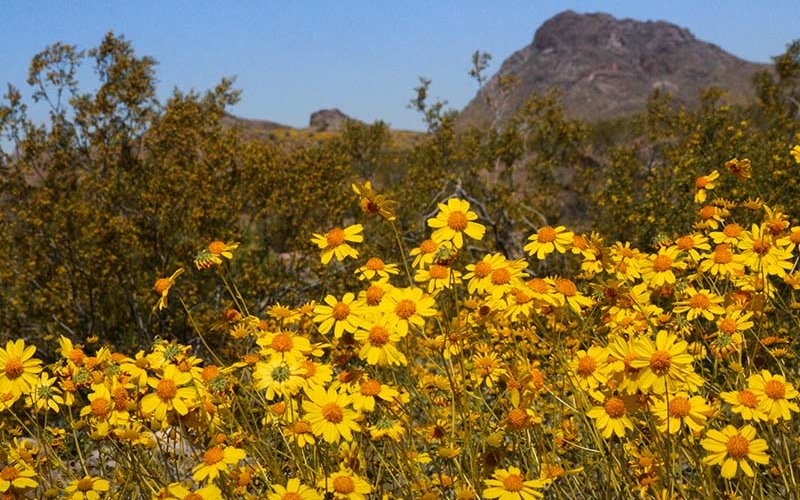
Brittlebush is a desert shrub that is adapting and showing a remarkable ability to respond to climate changes in water availability and temperatures, even in places like Death Valley, one of the hottest and driest places on the planet, according to a new published study.
Over the past 20 years, Cal State Fullerton ecologist Darren R. Sandquist and scores of his students, in collaboration with University of Utah scientists, have studied the brittlebush, a common desert shrub with silvery leaves and showy small yellow flowers. Found throughout the Southwest and northern Mexico, the shrub can live up to 30 years.
The study, which began in the 1980s, examined the long-term physiological changes in response to climate variability in order to predict how the species will survive with changing climate conditions in the future.
“The brittlebush has shown remarkable physiological adjustment to increasing levels of water stress over the past few decades,” said Sandquist, professor of biological science and director of the California State University’s California Desert Studies Consortium. “The plants have adjusted to changing environmental conditions, such as higher aridity and warmer temperatures, to a greater degree than expected.”
Sandquist is a co-author of the study, published in the Proceedings of the National Academy of Sciences.
The study relied on annual surveys over the past four decades at two long-term desert research sites in Death Valley, California, and near Oatman, Arizona. The research project, funded by the National Science Foundation, was established by University of Utah distinguished professor of biology Jim Ehleringer, Sandquist’s doctoral adviser.
Sandquist became involved in the research in the late 1980s as a graduate student at the University of Utah. After joining CSUF in 1999, Sandquist introduced his students to the research, and each spring, they have worked on the study with Ehleringer and his students to survey the plant populations and collect samples for lab analysis.
This spring, however, the researchers’ 40-year record almost ended due to the coronavirus pandemic. Because of the importance of the study and the remoteness of the desert, a scaled-down field research trip took place with permission from both universities. Only Sandquist and two researchers from the University of Utah conducted fieldwork.
“It’s easy to social distance when you’re working in the wide open Mojave Desert,” Sandquist said.
Over the years, Sandquist estimates he has brought more than 60 CSUF students to the desert to work on the research.
“I’m most proud of how this project has provided an immersive and diverse field experience for so many CSUF students. Not only do students learn about the brittlebush, but they also come to appreciate the value of long-term studies and the creativity needed to overcome seemingly impossible research questions,” he said.
Kassandra Rodriguez, a biological science-plant biology major, is among students who joined the study in spring 2019. Among tasks, she counted yearling plants to gage any new individuals joining the brittlebush population.
“It was a great experience to participate in the cross-institutional study. It was extremely beneficial as an undergraduate student to meet and make connections with other students and faculty members from a research institution like the University of Utah,” said Rodriguez, a scholar in the Southern California Ecosystems Research Program (SCERP).
Alumna Tracy Valentovich Popiel ‘07 (B.S. biological science-biodiversity, ecology and conservation), who was a SCERP scholar, worked on the study all four years as an undergraduate and research assistant in Sandquist’s lab.
What Popiel learned in the field and in the lab has helped her in her career as a geographic information systems specialist. At the environmental consulting company, she maps natural resources across California, including in the desert.
“My understanding of field data collection and GPS technology has helped guide my work with biologists at my company to ensure that proper methods are being used,” Popiel said. “Most importantly, I learned how to be a part of a team and conduct myself professionally with other scientists.”
Contact: Debra Cano Ramos, dcanoramos@fullerton.edu